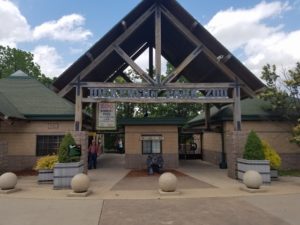
In May 2017, we stopped at the Dickerson Park Zoo (DPZ) on the way home from our St. Louis Zoo trip. As you can see from our review of DPZ, we loved it!
Once our DPZ review page was up, I shared one of my DPZ pictures on Facebook; it is a beautiful Green Tree Python.

DPZ liked and re-shared my picture on their Facebook, and it blew up. It went viral immediately, and I was over the moon! So Steve and I got to talking, and we decided that we should contact DPZ and tell them who we are and what we do. That’s when we met the incredible, amazing DPZ Public Relations Director, Joey Powell.
From the start, Joey was a pleasure to work with, and you could immediately tell she has a passion and love for DPZ. We would find out later that everyone from DPZ has the same love and passion.
Joey was able to help us by providing some additional facts and details about their Raptor Rehabilitation program and invited us to have a deeper look behind the scenes at Dickerson Park Zoo if we ever found ourselves around Springfield, MO again.
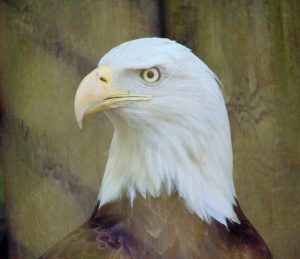
So a few months went by and we decided, okay we’re going to take another zoo trip. We found the Little Rock Zoo and Memphis Zoo were only a few hours from each other, and while we were there, it wasn’t too far out of the way to head up to Springfield and DPZ.
I emailed Joey and told her what we were doing. We set a date for us to visit and go behind the scenes. Joey met us at the front gate, and we felt like big shots in the golf cart driving around the zoo. It was a little surreal, and a memory Steve and I will cherish.
The first place Joey took us was to the giraffe barn where we met Matt, one of the keepers for the African animals.
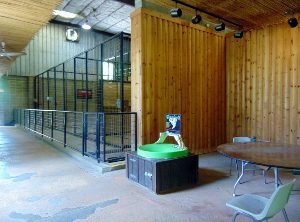
We also met Grady, the big male giraffe, but he lost interest in us after realizing we had no treats for him.
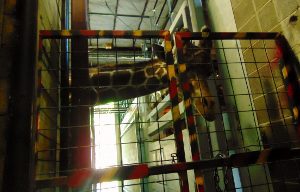
Outside of the giraffe building we got to meet one of the zoo’s newest editions. Azizi, a Rothschild giraffe, born only a few weeks earlier.
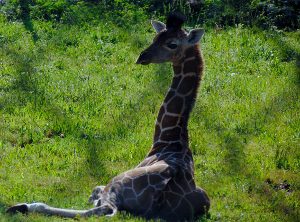
He was so cute and tiny….. well, “tiny” for a giraffe, but he was adorable! He was on exhibit with his mom and aunt, and behind us in another exhibit was the rest of the giraffe family.
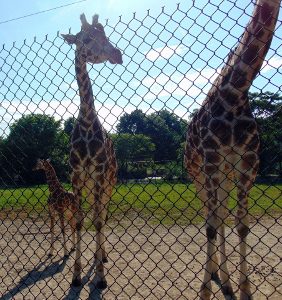
Steve and I got to nerd out with Keeper Matt for quite a while as we talked about giraffe genetics, the Species Survival Plan, and management techniques for handling zoo animals. It was fascinating to hear about the day to day activities as well as the deeper reasons behind them.
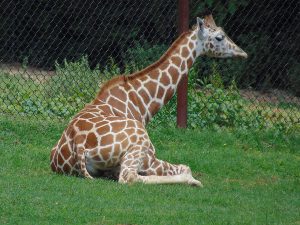
Keeper Matt told us about drawing blood from Azizi’s mom right before he was born. This allowed the zoo to have plasma on hand in an emergency. If needed this plasma could provide Azizi with vital antibodies from mom‘s blood if something went wrong with Azizi getting to drink his first milk, called colostrum.
DPZ is now able to keep the Giraffe blood and Plasma in a Cryo-freezer at the Vet Hospital.
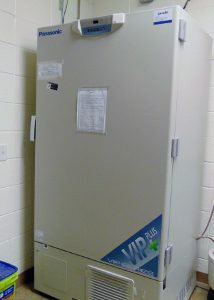
I know not everyone gets as excited about animal husbandry as we do, but we really enjoyed our discussions with Keeper Matt.
We learned about the techniques involved in drawing blood from the giraffes. You may be surprised to know that DPZ and other Association of Zoos and Aquariums (AZA) accredited zoos conduct procedures like blood drawing on a voluntary basis with the animals.
The animals are trained with a technique called targeting, where the animal places part of their body in a specific location for inspection or procedures in exchange for a treat. The key here is, the animal chooses to participate in the targeting.
Steve and I find when we describe targeting and other modern AZA management techniques to our friends, they are often impressed by the idea. They are surprised by how different and gentle this treatment is compared to what they expect goes on behind the scenes at zoos.
We learned about the importance of drawing blood from the giraffes not only for being ready to provide other giraffes blood, plasma, or antibodies if needed, but also we learned about the genetic research going on as part of the Species Survival Plan (SSP).
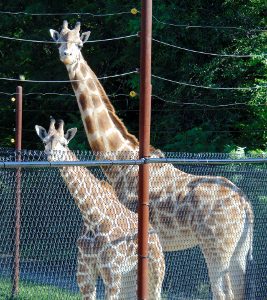
In an effort to preserve the threatened and endangered species of the world, AZA zoos just like DPZ submit samples (blood or tissue) for genetic analysis. Through the SSP, genetic matches can be identified at other AZA zoos as potential mates and genetic problems can be identified.
Without the efforts of zoos like DPZ working together through programs like SSP, many species like giraffes will be lost in our lifetime.
Those of you familiar with the purpose of The Zoo Review know, this is exactly why Steve and I do what we do! We want to tell you not only about why we love zoos, but why zoos are so important!
Keeper Matt, just like Steve and I, wants the world to know the number of giraffes and other species is declining, but programs and efforts like the SSP can make a difference!
From the giraffe area, we made our way to the African Lions and the Colobus Monkeys. The lions, just like any other cats, were being lazy and adorable laying on their perches. Just like your house cats, lions can easily spend 20 hours a day sleeping.
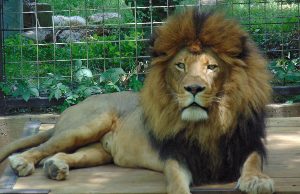
The lion’s pool had been drained the night before so it could be cleaned, but the lions had refused to leave their exhibit overnight.
Remember the whole voluntary thing we talked about with the giraffes? Yeah, same thing with the lions.
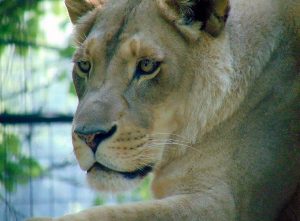
The lions decided they wanted to spend the night in their exhibit instead of going inside to eat. So, the keepers didn’t get an opportunity to clean and refill the pool.
This brought up an interesting bit of conversation. Joey told us they get several concerned emails and calls about animals having no water or dirty water in their enclosure.
Of course, the DPZ staff is happy people are concerned about the animals. However, you can rest assured all of the animals in any AZA zoo always have access to clean water for drinking.
The water features and pools in their exhibit are often for enrichment and not drinking. We noticed later that DPZ had placed several signs throughout the zoo explaining the animals had access to clean drinking water even if it wasn’t visible to patrons.
While watching the lions, a young male Colobus monkey had come to the fence of his enclosure behind us. He was trying to get our attention, and he was really cute! His dad and the rest of the troop were staying at the back of the enclosure enjoying the morning sun.
Keeper Matt explained the dad had been identified through the SSP as one of the best genetic Colobus males in the country. Information like this helps AZA zoos make responsible and sustainable choices for identifying mates for their animals to conserve endangered species.
We walked over to the Ringtail Lemur habitat to see the cutest baby lemur, Pepper. She was hanging out on her Mom‘s back.
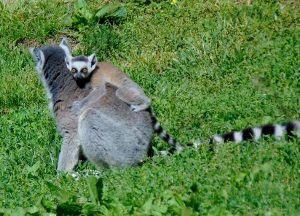
Keeper Matt tried to pick up Pepper to examine her while Joey fed her mom some grapes, but mom was not having it.
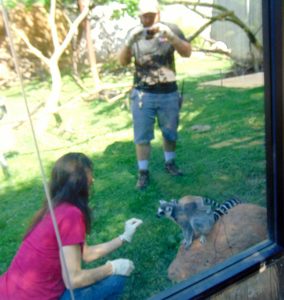
Still, we were able to take some really good pictures of Pepper, her mom, and her dad.
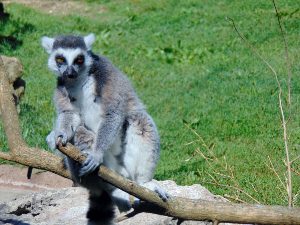
From there, we parted ways with Keeper Matt, and Joey took us to see some of the support facilities at DPZ. We took a quick tour of the commissary where the food for the animals is kept, and we learned about some of the ways DPZ receives food donations.
We found out a local branch of a nationally known brand which arranges edible fruits in baskets for gifts (we’re not sure we can use their name here) donates their fruit trimmings to DPZ. Additionally, the DPZ benefits on occasion from donated deer carcasses killed in vehicle accidents.
The take home message here is rather clear: If you or your business would like to help zoos, be sure and contact your local zoo about their needs and donation options. Several zoos will have a “wish list” available through their website.
You know how you wouldn’t want 20 toasters for your birthday or as wedding gifts? It’s the same thing here! Zoos will have needs for a wide variety of donations. Contact them, and see what they need the most right now.
We then visited the DPZ’s Veterinarian and Quarantine facilities and learned about their Raptor Rehabilitation program. Here we met Dr. Rodney, the staff veterinarian at DPZ. We got a full tour, and Dr. Rodney introduced us to some of his patients.
We met an otter who had recently undergone surgery, and she was telling us ALL about how upset she was that she couldn’t swim for a few days after an ovarian cyst removal surgery! Otters can be very vocal!
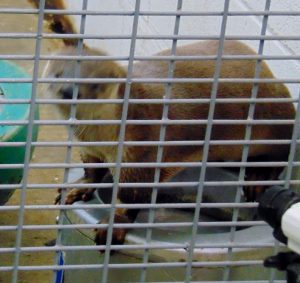
As I mentioned, DPZ has a Raptor Rehabilitation program which is well known in the state of Missouri and is quite successful. We met a Red-tail Hawk, a young and noisy Crow, a juvenile American Bald Eagle, a group of baby Kestrels, and several other birds who were recovering under the watchful eye of Dr. Rodney and his staff.
All of these birds were recovering from some sort of injury and had been brought to the zoo by good Samaritans. Some of these wildlife heroes (who are often just everyday people) had driven hours to deliver these birds to DPZ and give them another chance at life.
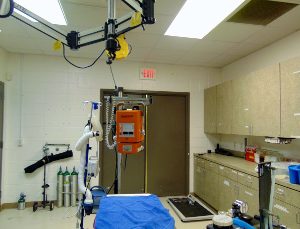
The Raptor Rehab program at the DPZ has a success rate around 30 percent for recovery with the ultimate goal of releasing the birds back into the wild. While 30 percent may not sound very high, it is actually quite high for programs of its kind, and it provides a much higher likelihood of survival for the birds than trying to recover on their own in the wild.
Joey explained how awesome and gratifying it is to release a majestic raptor back to the wild after it has been successfully rehabilitated. We could tell from our conversations throughout the day with all of the DPZ staff they take a lot of pride in this program, as they should!
To increase the likelihood the birds can be released back to the wild after rehab, Dr. Rodney and the DPZ staff utilize a few tools and techniques.
Cages for the rehabbing birds are often covered with a blind to prevent the birds from seeing humans regularly and imprinting or becoming habituated to people.
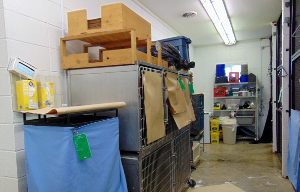
Additionally, the DPZ has a flight cage for the rehabbing birds that was made possible by a donation from a generous couple who loves zoos.
This long and narrow wooden cage is designed to allow birds an opportunity to fly back and forth and stay in flying shape while recovering. It’s like a physical therapy center for raptors!
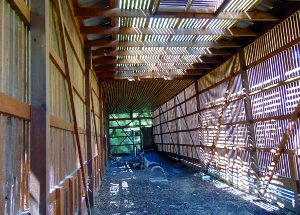
One of the last things that Dr. Rodney wanted us to see was the breeding pens for the Maned Wolves.
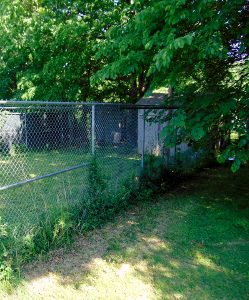
See, here’s the thing about these musky canine creatures, they are VERY private! Steve and I RARELY get a good picture of these elusive cuties, because they are almost always hiding when we see them at a zoo.
So, if you want any chance of having cute cuddly little musky Maned Wolf puppies, you need a really quiet, secluded area for mom and dad to…… brown chicken brown cow…… you know what I mean. This nice, quiet spot behind the scenes is exactly what the doctor ordered. Literally.
Before we parted ways with Dr. Rodney, Steve asked him the same question we posed to several DPZ personnel that day: what is the one thing YOU would like the public to know about DPZ?
Dr. Rodney wanted to make sure we understood just how dedicated the keepers are to the animals. Joey echoed this sentiment several times throughout the day.
To help illustrate this dedication, Dr. Rodney suggested we visit the Spider Monkey habitat which was being remodeled. So we took a short golf cart ride back into the zoo and headed to the South American habitats.
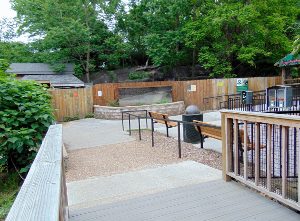
The heart and soul the DPZ staff puts into their habitats is inspiring. We knew from our talks with Keeper Matt earlier in the day, DPZ does almost all of the habitat construction and remodeling themselves.
Keeper Matt had already shown us several habitats and talked about the time and effort the keepers, staff, and DPZ family put into creating the most enriching habitats for the animals.
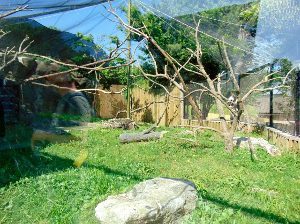
Keeper Matt was proud to mention his wife has played an active role in the painting, building, and design of elements within several of the DPZ habitats.
When we say the entire DPZ family is dedicated to the animals, we mean it! We found the ownership and pride the keepers take in their design and construction of enriching habitats serves as really good evidence.
We reached the Spider Monkey habitat to find the remodeling process going quite well, but there was a pause in the action.
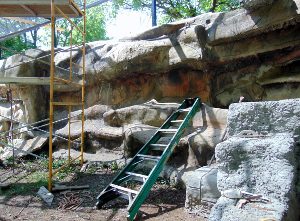
A tree was being constructed in the middle of the habitat, and when it’s finished it will be a great source of fun, exercise, and enrichment for the cute little Spider Monkeys.
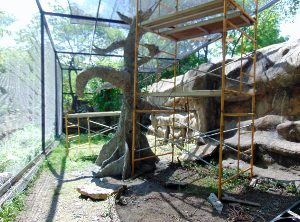
Steve and I are excited to come back when it’s finished. However, several of the keepers and volunteers were occupied with an issue more pressing (and more adorable) than the remodeling.
Behind the Spider Monkey habitat was the temporary home for two of DPZ’s newest residents. Trixie and Janis are a pair of Two Toed Sloths, and the keepers were trying to move them to their newly prepared habitat on the other side of the zoo.
Janis had already happily jumped into her bucket before we arrived. Well….. ok; she’s a sloth. I’m pretty sure she had slowly crawled into her bucket, but in any case, she was ready to go for a ride!
Trixie on the other hand was being difficult. She had found a nice perch and was not interested in getting into a carrier despite the best efforts of the keepers and volunteers.
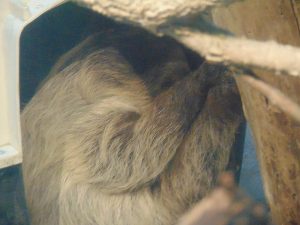
Like we said earlier, everything done with the animals is done on a voluntary basis. If they don’t want to do it, it isn’t happening!
While we didn’t get to see the keepers working on remodeling a habitat, we got a great look at all of the work and dedication the DPZ family has put into their habitats over the years, and we got to meet a couple of sloths! How cool was this day? And, we weren’t even finished yet!
One of the last and most exciting things we got to see was the education facilities and a group of young conservationists in the making!
Joey took us to see an active classroom where young students were conducting a basic science experiment and meeting some of DPZ’s animal ambassadors.
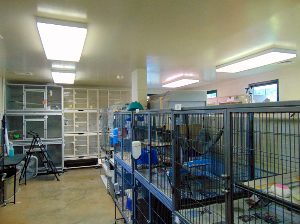
The students, who were younger than kindergarten age, were learning about solubility through the use of lemonade and a sugar cubes. The teacher would place a sugar cube in each student’s cup of lemonade with a cute little Ker plunk.
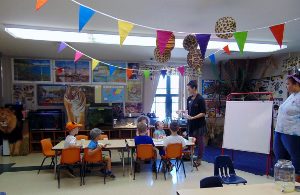
After everyone had a sugar cube in their lemonade, the teacher asked the students, “what do you think will happen to the sugar cube?” One little girl thought hers would melt. Another little boy thought his would get smaller.
Of course, most of us that have conducted a science experiment might recognize what these little ones were doing as forming a hypothesis. Soon, the little scientists would get to test these hypotheses in the sweetest way possible (yes, pun intended). Steve and I thought this was an excellent, simple way to get these little ones interested in science.
This could easily get them started on the long and rewarding path to any STEM career including Wildlife Conservation, Biology, or Zoology.
So, what did we learn during this behind the scenes tour? The Keepers at Dickerson Park Zoo are incredibly dedicated to the wellbeing of the animals. The supporting staff are incredibly dedicated to the Keepers. Also, everyone at the Dickerson Park Zoo is dedicated to the success of the Zoo as a whole!
We learned more about targeting, all target training and procedures are voluntarily unless an emergency occurs. The animals choose to participate.
We learned more about the Species Survival Plan, and the babies born in AZA zoos are carefully coordinated to give endangered species the best chance at survival both in and out of captivity.
Finally, we had a pretty good idea that AZA zoos take incredible care of their animals. This trip really confirmed this for us.
It was an honor to meet the people who dedicate so much to the DPZ and the DPZ animals. Also, it was a pleasure to see a little bit of the day to day operations and meet some of the zoo’s amazing animal residents.
We can’t wait to go back to the Dickerson Park Zoo again!